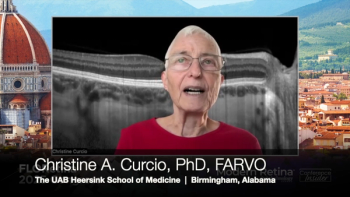
AAO 2025: Subretinal drusenoid deposits in Black and Hispanic patients with AMD
The investigators noted that this report is the first about subretinal drusenoid deposits in Black and Hispanic patients with age-related macular degeneration
Researchers from the New York Eye and Ear Infirmary of Mount Sinai, New York, reported that subretinal drusenoid deposits (SDDs) in patients with
The authors, John Tan, BA, and colleagues, presented their findings during a poster session at the 2025 American Academy of Ophthalmology Annual Meeting in Orlando.1
Tan is from the Department of Ophthalmology, Icahn School of Medicine at Mount Sinai, New York Eye and Ear Infirmary of Mount Sinai, New York.
He explained that SDDs and soft drusen are the two main forms of intermediate AMD seen on optical coherence tomography (OCT) images. However, SDDs have been associated with more rapid progression of AMD than soft drusen,² and patients with SDDs die at a younger age. He and his colleagues wanted to determine why that was true.
The investigators said that while SDDs previously have been linked strongly to high-risk vascular diseases, such as myocardial infarction, congestive heart failure, valvular diseases, and stroke/transient ischemic attacks,3 and Black and Hispanic patients are at higher risk of death from high-risk vascular diseases compared with white patients.4-6 Investigators pointed out that these deposits have not been reported specifically in Black and Hispanic patients.
Cross-sectional study
Tan and colleagues identified 23 Black and Hispanic patients with AMD among 200 patients in a previously published report. The subjects’ ophthalmic imaging and lipid profiles were obtained. Subjects then were classified as having SDDs (with or without drusen) or soft drusen only and assigned as those with or without high-risk vascular diseases, the authors recounted.
Ten patients (3 Black and 7 Hispanic patients) were found among the 23 subjects to have SDDs with no phenotypic differences from white patients. Three of the 10 had high-risk vascular diseases.
The subfoveal choroidal thicknesses in patients with and without SDDs were, respectively, 166.6 ± 59.2 µm and 208.5 ± 83.2 µm. The respective high-density lipoprotein (HDL) levels were 52.4 ± 11.7 mg/dL and 60.2 ± 15.6 mg/dL.
Commentary on the findings
The investigators noted that this report is the first about SDDs in Black and Hispanic patients with AMD.
Compared with white patients with AMD, the phenotypic presentation and the prevalence rates were similar, i.e., 50% of the Caucasian patients with AMD in the parent study and 43.5% of the Black and Hispanic patients had AMD, and the white patients with SDDs had lower HDL values compared with those without SDDs, i.e., 61 versus 69 mg/dL. Thinner choroids have been reported previously in association with SDDs.7-9
The investigators concluded that SDDs are present in Black or Hispanic patients with AMD. “Likely these patients have a similarly increased risk for advanced AMD as SDDs in white patients,” Tan and colleagues commented.
Importantly, they advised that “a diligent search for SDDs” is warranted in Black and Hispanic patients with AMD, especially when the strong association between SDDs and high-risk vascular diseases and the increased risk of high-risk vascular diseases in these patient populations are considered.
References
Tan, John M., et al. "Age-related macular degeneration, subretinal drusenoid deposits, and cuticular and calcified drusen in Black and Hispanic subjects." International Journal of Retina and Vitreous 11.1 (2025): 85.
Spaide RF, Ooto S, Curcio CA. Subretinal drusenoid deposits AKA pseudodrusen. Surv Ophthalmol. 2018;63:782-815.
Ledesma-Gil G, Otero-Marquez O, Alauddin S, et al. Subretinal drusenoid deposits are strongly associated with coexistent high-risk vascular diseases. BMJ Open Ophthalmol. 2022;7:e001154.
Shaw PM, Chandra V, Escobar GA, et al. Controversies and evidence for cardiovascular disease in the diverse Hispanic population. J Vasc Surg. 2018;67:960-9.
Soden PA, Zettervall SL, Deery SE, et al. Black patients present with more severe vascular disease and a greater burden of risk factors than white patients at time of major vascular intervention. J Vasc Surg. 2018;67:549-56. e3.
Brewer LC, Cooper LA. Race, discrimination, and cardiovascular disease. VM. 2014;16:455-60.
Spaide RF. Disease expression in nonexudative age-related macular degeneration varies with choroidal thickness. Retina. 2018;38:708-16.
Cheng H, Kaszubski PA, Hao H, et al. The relationship between reticular macular disease and choroidal thickness. Curr Eye Res. 2016;41:1492-7.
Keenan TD, Klein B, Agrón E, et al. Choroidal thickness and vascularity vary with disease severity and subretinal drusenoid deposit presence in nonadvanced age-related macular degeneration. Retina. 2020;40:632.
Newsletter
Get the essential updates shaping the future of pharma manufacturing and compliance—subscribe today to Pharmaceutical Technology and never miss a breakthrough.







































